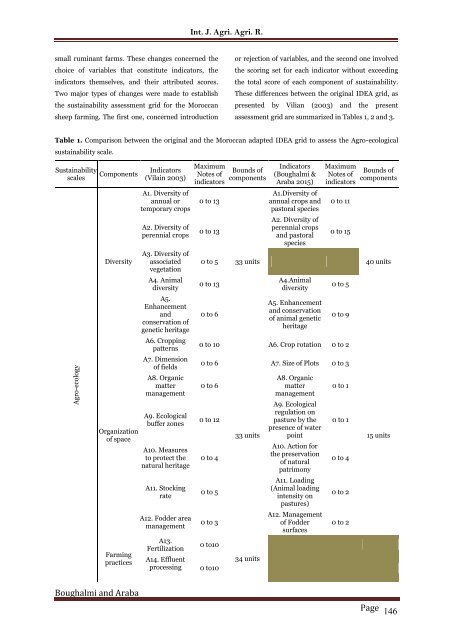Assessment of farm-level sustainability indicators for Moroccan sheep farming systems using an adapted IDEA approach analysis
Abstract Intensification of livestock farming during the last decades has raised many issues including ecological impacts and food security. In the Middle Atlas of Morocco, extensive sheep production systems are facing changes and constraints that may influence their sustainability. In this paper we present an adapted approach from IDEA (Indicateurs de la Durabilité des Exploitations Agricoles) method to evaluate the sustainability of sheep farming systems in the Eastern Middle Atlas, Morocco. For this purpose, 75 farms were selected from three production system in the area i.e. Agro-silvo-pastoral, Pastoral and Olive-grave based oasis systems. The assessment of sustainability of farms showed that agro-silvo-pastoral and pastoral ones presented higher score for sustainability compared to the olive-grave based oasis ones (P<0>0.05). Analyze of sustainability scores demonstrated that the sustainability of agro-silvo pastoral farms is limited by the economic characters, while the agro-ecological aspects seem to be the weakness points of the olive-grave based oasis farms. Pastoral farms presented balanced scores for the three scales of sustainability. Consequently, improving these aspects could, on one hand, improves the global sustainability of the three sheep farming systems and, on the other hand, guaranties the continuity of this sector in the Moroccan Middle Atlas area.
Abstract
Intensification of livestock farming during the last decades has raised many issues including ecological impacts and food security. In the Middle Atlas of Morocco, extensive sheep production systems are facing changes and constraints that may influence their sustainability. In this paper we present an adapted approach from IDEA (Indicateurs de la Durabilité des Exploitations Agricoles) method to evaluate the sustainability of sheep farming systems in the Eastern Middle Atlas, Morocco. For this purpose, 75 farms were selected from three production system in the area i.e. Agro-silvo-pastoral, Pastoral and Olive-grave based oasis systems. The assessment of sustainability of farms showed that agro-silvo-pastoral and pastoral ones presented higher score for sustainability compared to the olive-grave based oasis ones (P<0>0.05). Analyze of sustainability scores demonstrated that the sustainability of agro-silvo pastoral farms is limited by the economic characters, while the agro-ecological aspects seem to be the weakness points of the olive-grave based oasis farms. Pastoral farms presented balanced scores for the three scales of sustainability. Consequently, improving these aspects could, on one hand, improves the global sustainability of the three sheep farming systems and, on the other hand,
guaranties the continuity of this sector in the Moroccan Middle Atlas area.
You also want an ePaper? Increase the reach of your titles
YUMPU automatically turns print PDFs into web optimized ePapers that Google loves.
Agro-ecology<br />
Int. J. Agri. Agri. R.<br />
small rumin<strong>an</strong>t <strong>farm</strong>s. These ch<strong>an</strong>ges concerned the<br />
choice <strong>of</strong> variables that constitute <strong>indicators</strong>, the<br />
<strong>indicators</strong> themselves, <strong>an</strong>d their attributed scores.<br />
Two major types <strong>of</strong> ch<strong>an</strong>ges were made to establish<br />
the <strong>sustainability</strong> assessment grid <strong>for</strong> the <strong>Morocc<strong>an</strong></strong><br />
<strong>sheep</strong> <strong>farm</strong>ing. The first one, concerned introduction<br />
or rejection <strong>of</strong> variables, <strong>an</strong>d the second one involved<br />
the scoring set <strong>for</strong> each indicator without exceeding<br />
the total score <strong>of</strong> each component <strong>of</strong> <strong>sustainability</strong>.<br />
These differences between the original <strong>IDEA</strong> grid, as<br />
presented by Vili<strong>an</strong> (2003) <strong>an</strong>d the present<br />
assessment grid are summarized in Tables 1, 2 <strong>an</strong>d 3.<br />
Table 1. Comparison between the original <strong>an</strong>d the <strong>Morocc<strong>an</strong></strong> <strong>adapted</strong> <strong>IDEA</strong> grid to assess the Agro-ecological<br />
<strong>sustainability</strong> scale.<br />
Sustainability<br />
scales<br />
Components<br />
Diversity<br />
Org<strong>an</strong>ization<br />
<strong>of</strong> space<br />
Farming<br />
practices<br />
Indicators<br />
(Vilain 2003)<br />
A1. Diversity <strong>of</strong><br />
<strong>an</strong>nual or<br />
temporary crops<br />
A2. Diversity <strong>of</strong><br />
perennial crops<br />
A3. Diversity <strong>of</strong><br />
associated<br />
vegetation<br />
A4. Animal<br />
diversity<br />
A5.<br />
Enh<strong>an</strong>cement<br />
<strong>an</strong>d<br />
conservation <strong>of</strong><br />
genetic heritage<br />
A6. Cropping<br />
patterns<br />
A7. Dimension<br />
<strong>of</strong> fields<br />
A8. Org<strong>an</strong>ic<br />
matter<br />
m<strong>an</strong>agement<br />
A9. Ecological<br />
buffer zones<br />
A10. Measures<br />
to protect the<br />
natural heritage<br />
A11. Stocking<br />
rate<br />
A12. Fodder area<br />
m<strong>an</strong>agement<br />
A13.<br />
Fertilization<br />
A14. Effluent<br />
processing<br />
Maximum<br />
Notes <strong>of</strong><br />
<strong>indicators</strong><br />
0 to 13<br />
0 to 13<br />
0 to 5<br />
0 to 13<br />
0 to 6<br />
0 to 10<br />
Bounds <strong>of</strong><br />
components<br />
33 units<br />
33 units<br />
Indicators<br />
(Boughalmi &<br />
Araba 2015)<br />
A1.Diversity <strong>of</strong><br />
<strong>an</strong>nual crops <strong>an</strong>d<br />
pastoral species<br />
A2. Diversity <strong>of</strong><br />
perennial crops<br />
<strong>an</strong>d pastoral<br />
species<br />
A4.Animal<br />
diversity<br />
A5. Enh<strong>an</strong>cement<br />
<strong>an</strong>d conservation<br />
<strong>of</strong> <strong>an</strong>imal genetic<br />
heritage<br />
Maximum<br />
Notes <strong>of</strong><br />
<strong>indicators</strong><br />
0 to 11<br />
0 to 15<br />
0 to 5<br />
0 to 9<br />
A6. Crop rotation 0 to 2<br />
0 to 6 A7. Size <strong>of</strong> Plots 0 to 3<br />
0 to 6<br />
0 to 12<br />
0 to 4<br />
0 to 5<br />
0 to 3<br />
0 to10<br />
0 to10<br />
34 units<br />
A8. Org<strong>an</strong>ic<br />
matter<br />
m<strong>an</strong>agement<br />
A9. Ecological<br />
regulation on<br />
pasture by the<br />
presence <strong>of</strong> water<br />
point<br />
A10. Action <strong>for</strong><br />
the preservation<br />
<strong>of</strong> natural<br />
patrimony<br />
A11. Loading<br />
(Animal loading<br />
intensity on<br />
pastures)<br />
A12. M<strong>an</strong>agement<br />
<strong>of</strong> Fodder<br />
surfaces<br />
0 to 1<br />
0 to 1<br />
0 to 4<br />
0 to 2<br />
0 to 2<br />
Bounds <strong>of</strong><br />
components<br />
40 units<br />
15 units<br />
Boughalmi <strong>an</strong>d Araba<br />
Page 146





![Review on: impact of seed rates and method of sowing on yield and yield related traits of Teff [Eragrostis teff (Zucc.) Trotter] | IJAAR @yumpu](https://documents.yumpu.com/000/066/025/853/c0a2f1eefa2ed71422e741fbc2b37a5fd6200cb1/6b7767675149533469736965546e4c6a4e57325054773d3d/4f6e6531383245617a537a49397878747846574858513d3d.jpg?AWSAccessKeyId=AKIAICNEWSPSEKTJ5M3Q&Expires=1718560800&Signature=zNT0xzcr9HqxxY7Q1vJdxxH7%2Blw%3D)












